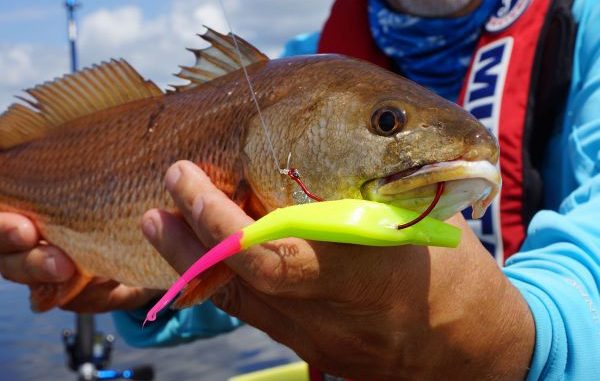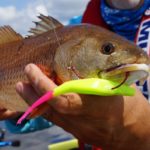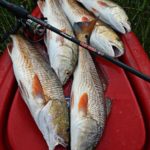
’Yaks are perfect for shallow-water stalking
As the weather warms, so does the water temperature. Submerged grass grows, and shrimp and baitfish invade the marsh — and so do redfish.
Shallow ponds are perfect places to look for summertime reds, and there’s no better way to do that than in a kayak.
Louisiana’s marsh bottoms are a mucky, muddy mess, and cannot be wade fished. The remote locations of these ponds do not provide any shore access, and most powerboats draft too much water to ply these fish-laden hot spots.
However, slip in with a kayak and you’ll likely have the area all to yourself.
Shallow pockets, coves and ponds with water that is only a couple of feet deep are great places to look for reds. To avoid unnecessary paddling, study a map or online resources such as Google Earth before your trip.
Casting out of a kayak is easier to the side of the kayak away from your casting hand. If possible, plan a route that keeps the bank on that side.
Redfish cruise grassy shorelines to ambush bait or dig crustaceans off the bottom. While staying 20 to 30 yards off the bank and casting to it can be productive, it only keeps your bait in the prime strike zone for only a short distance and really wastes the stealthy nature of the kayak.
You’ll be far more productive fishing parallel to the shore, where your casts can be retrieved next to the bank. This keeps your bait in the zone for the entire retrieve.
Work your lures all the way back to the kayak. Redfish will often follow and strike when it gets within a few feet of the boat.
By picking a length of shoreline and casting ahead, you avoid spooking the shallow-feeding fish and can slowly move forward after each cast.
Keep a constant lookout for signs of feeding fish or nervous bait. In really shallow ponds it’s not uncommon to see redfish tails waving above the water, and sometimes their whole back is sticking out.
If you spot a fish, don’t immediately cast or you might end up spooking it. Take a few seconds to assess which way the fish is facing and whether it is still or moving. Always plan your cast to land well past the red, where the lure can be brought toward it, at a crossing angle. This presents the bait in a more-realistic manner.
Not many baitfish or shrimp swim directly toward a hungry redfish (at least not more than once). The plan is to suddenly catch the red’s attention, which more often than not triggers a reaction strike.
Redfish have a thick lateral line that can sense the slightest of vibrations in the water. This alerts them to the presence of your bait. If you can see the fish when you cast, you will usually see the fish react as it senses the bait hitting the water. Longer casts are less likely to spook the fish.
As the lure is reeled closer, the red will sense the bait and home in on its location.
The lateral line can also be a curse. Not only does it sense vibrations, it can also detect changes in pressure.
Even shallow-draft kayaks displace water and can alert fish to your presence through their lateral line. Slow, deliberate movements with little splashing will help keep you undetected when pursuing shallow-water redfish.
While standing can help spot reds cruising in shallow water, it also makes you more visible. Do your best to keep as low a profile as possible. Using a good pair of polarized sunglasses helps spot fish at farther distances, thereby lessening your chance of spooking them.
Redfish are not picky eaters, and will generally hit anything in their vicinity. A friend recently cleaned a red with an empty shotgun shell hull in its stomach. There’s no doubt the spent shell was floating and bobbing, and was hit by the red as it would a topwater lure.
Live bait is always a good bet. Reds are suckers for shrimp, minnows and small blue crabs. However, a wide variety of artificial lures will also do the trick.
If there is a lot of grass, use baits that don’t have exposed hooks. Weedless spoons, jerk baits and in-line spinnerbaits can easily be worked above and through the grass where the reds will be lurking.
But don’t overlook common bass lures. A Texas-rigged plastic worm is great for thick grass and makes minimal splash when the fish are acting spooky.
If the water is relatively clear of grass, or it’s high enough where the vegetation is a few inches below the surface, using a topwater bait provides for great shallow-water action. Redfish will readily attack a topwater lure, but due to the orientation of their mouths, it oftentimes takes two or three hits before they get hooked up. If the first strike is a miss, don’t despair. Keep the lure in the same area and be prepared for the fish to return for another try.
Redfish have hard mouths with strong crushers inside. Using smaller floating lures will increase your hook-up ratio, but that generally requires changing out the stock hooks to extra-strong models.
Short, fat, crankbaits are great for shallow-water reds. Use models with small lips that run on or just below the surface.
One of the most-productive and exciting topwater baits to use is a wake bait. These are small, floating crankbaits that have short lips that point nearly straight down. The lures run at or just an inch or 2 under the surface, depending on the speed of the retrieve. The wake bait has a tight wiggle and rattles inside that can be heard from far away.
Spinnerbaits, whether traditional “safety pin” models or in-line also make great lures for redfish. These lures can be burned near the surface or slow-rolled, depending on how the fish are reacting on a particular day.
One of the main benefits of fishing from a kayak is the ability to access areas where others cannot go. Take advantage of that by getting deep into the marsh where schools of hungry redfish are virtually untouched. If there’s enough water to float your ’yak there’s enough water to hold reds.




